With assistance from the Vermont Diesel Emissions Reduction Grants, several Vermont businesses and institutions have successfully completed various diesel emission reduction projects including diesel engine repowering at local sawmills, engine replacements onboard the m/v Spirit of Ethan Allen III, vehicle replacement at schools, municipalities, and local businesses, and installation of idle reduction technologies used by hospitals, railways and schools.

Learn more about Vermont Diesel Emissions Reduction Grants.
 As part of the diesel emission reduction efforts in Vermont, reducing children's exposure to diesel exhaust is a primary area of focus. Children are more susceptible to air pollution than healthy adults because their respiratory systems are still developing and they have faster breathing rates. Under the Vermont Diesel Emissions Reduction Grants program, the Burlington School District successfully replaced an older diesel-powered tractor, used to maintain school grounds, with a newer, cleaner technology tractor, achieving a 55% reduction in NOx and hydrocarbons emissions.
As part of the diesel emission reduction efforts in Vermont, reducing children's exposure to diesel exhaust is a primary area of focus. Children are more susceptible to air pollution than healthy adults because their respiratory systems are still developing and they have faster breathing rates. Under the Vermont Diesel Emissions Reduction Grants program, the Burlington School District successfully replaced an older diesel-powered tractor, used to maintain school grounds, with a newer, cleaner technology tractor, achieving a 55% reduction in NOx and hydrocarbons emissions.
Recently, AQCD has partnered with the Village of North Bennington for the early replacement of a backhoe, as well as The Belden Company for the early replacement of a wheel loader. These two projects were successfully completed in 2018 and resulted in the following air pollution reductions.
| Pollutant | PM2.5 | NOx | HC | CO |
|---|---|---|---|---|
| % Reduced | 99% | 95% | 87% | 98% |
| Annual Reduction (short tons) | 0.01 | 0.07 | 0.01 | 0.07 |
| Lifetime Reduction (short tons) | 0.06 | 0.35 | 0.06 | 0.37 |

- PM 2.5 – Fine particulate matter (2.5 microns or less).
- NOx – Nitrogen oxides.
- HC – Hydrocarbons.
- CO – Carbon monoxide.
| Pollutant | PM2.5 | NOx | HC | CO |
|---|---|---|---|---|
| % Reduced | 98% | 95% | 62% | 95% |
| Annual Reduction (short tons) | 0.05 | 0.47 | 0.02 | 0.13 |
| Lifetime Reduction (short tons) | 0.55 | 5.17 | 0.23 | 1.46 |

- PM 2.5 – Fine particulate matter (2.5 microns or less).
- NOx – Nitrogen oxides.
- HC – Hydrocarbons.
- CO – Carbon monoxide.
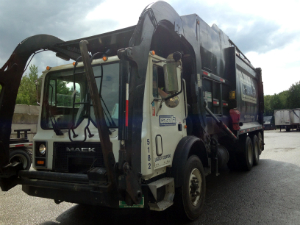
The project was designed to provide the benefits of improved air quality to operators as well as the public in cities, villages and town centers with larger populations. The grant program provided 100% of the funding necessary and through the deployment of DOCs, a reduction in harmful emissions locally has been achieved. The DOCs installed on the refuse haulers are EPA Verified Exhaust Control Technologies, attaining the following emission reductions:
| Pollutant | PM2.5 | HC | CO |
|---|---|---|---|
| % Reduced | 20% | 50% | 50% |
| Annual Reduction (short tons) | 0.06 | 0.14 | 0.55 |
| Lifetime Reduction (short tons) | 0.53 | 1.27 | 5.03 |
- PM 2.5 – Fine particulate matter (2.5 microns or less).
- HC – Hydrocarbons.
- CO – Carbon monoxide.

The primary goal of school bus retrofit efforts in Vermont has been to help reduce diesel emissions and children's exposure to diesel exhaust from school buses. With funding from EPA's Clean School Bus USA program, DEC provided technical and financial assistance to Vermont school districts statewide to retrofit over fifty school buses with a combination of diesel oxidation catalysts (DOCs), closed-crankcase ventilation (CCV) systems, and auxiliary fuel operated heaters (FOHs). The program was successful in reducing diesel school bus emissions and improving fleet fuel efficiency, and the effectiveness of these technologies was demonstrated to a broad audience of school bus administrators throughout the state. To learn more about school bus retrofits, please review our Fact Sheet and visit Vermont Diesel Emissions Reduction Grants.
Vermont DEC developed a grant program with funding from the Diesel Emissions Reduction Act (DERA) to help upgrade the statewide public school bus fleet by accelerating the replacement and scrappage of older buses with new buses equipped with state-of-the-art emissions control systems and idle reduction technology. Enabling public school districts throughout the state to conduct early replacement and scrappage of older school buses with newer, cleaner buses will allow today's generation of school children to reap the benefits of currently-available technologies that reduce harmful diesel emissions.

Numerous schools and supervisory unions applied to participate in the Vermont Diesel Emissions Reduction Grants program and at the completion of this project, 60 older, more heavily polluting school buses were replaced ahead of schedule with new buses equipped with state-of-the-art emissions control systems and idle reduction technology. This project has reduced children and school faculty’s exposure to harmful diesel exhaust and at the same time reduced the amount of air pollution generated from diesel powered school buses.
"A teacher and a group of middle school students became very interested in the amount of time that the buses were idling in front of the school. They brought this to our attention and kept after us until we responded [by adopting a policy to limit idling]. It was a great lesson in advocacy and involvement and change. It was great to have a teacher and students take the lead!"
"[In addition to adopting policy,] it is a source of pride that CESU has researched the technology and taken advantage of options to improve our fleet of buses." - Patricia Connelly, Grants Coordinator, Chittenden East Supervisory Union Participant, Vermont Breathe Better Campaign Grantee, Clean Bus USA and DERA program


Diesel powered locomotives emit high levels of particulate matter, nitrogen oxides and greenhouse gases, and normally idle whenever the locomotive is stationary and the temperature is below 40º F. The Vermont Department of Environmental Conservation’s Air Quality & Climate Division (AQCD) has developed a grant program to help reduce diesel emissions when the locomotives are stationary. The AQCD, through its Diesel Emissions Reduction Grants, provides technical assistance and funding for the installation of idle-reduction technology for locomotives. This onboard equipment reduces the need for locomotive engine idling, thus improving local air quality while also reducing fuel consumption.
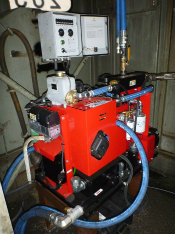
The AQCD has partnered with Vermont Railway, Inc. and New England Central Railroad (NECR) to complete idle reduction projects. Under the Vermont Diesel Emissions Reduction Grants program, auxiliary power units (APUs) have been installed on a NECR locomotive and six Vermont Railway, Inc. locomotives. The APUs provide auxiliary power for battery charging and maintain engine coolant and oil temperatures, essentially eliminating the need to idle. Typically, a locomotive uses about five gallons of diesel fuel per hour of idling. Operating an APU in place of idling the locomotive engine, results in fuel savings of more than 90%.
Through these projects, a significant reduction in diesel emissions, as well as fuel savings are realized.
Learn more about the Vermont Diesel Emissions Reduction Grants.
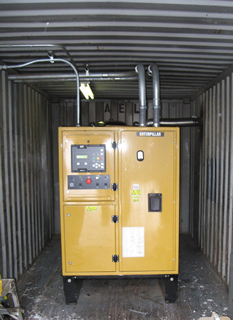
Three sawmills applied to replace a total of four diesel powered generators, and each was approved to receive a 50% cost-matching grant and technical assistance in repowering this equipment with lower-emitting diesel engines that has resulted in emissions reductions of up to 80%. This project involved the removal and scrapping of existing diesel powered generators, and their replacement with new ones certified to a more stringent set of emissions standards. AQCD also provided technical assistance to sawmill owners throughout the process of selecting, developing specifications for, purchasing, and installing new generators as well as disposing of existing ones.
Through this project, exposure to harmful contaminants in diesel exhaust has been reduced and the public health, environmental and cost benefits of these technologies has been demonstrated to a broader audience throughout Vermont. Reducing public exposure to emissions from diesel-powered engines is a significant air quality challenge. Even with more stringent engine standards in effect for new heavy-duty highway and non-road equipment, millions of diesel engines already in use will continue to emit large amounts of particulate matter, nitrogen oxides, air toxics and greenhouse gases, which contribute to serious risks to public health and the environment. Diesel emissions are linked to premature deaths, asthma attacks, lost work days, and numerous other health and environmental impacts.
 "[With the funding provided by Vermont AQCD,] we replaced two old units and found the new generators, although slightly smaller in size, presented more horsepower. We have cut diesel fuel usage, conservatively, by 1,000 gallons a year. There is no smoke even when we run a heavy load. We probably couldn't have taken advantage of all of [this technology] without the grant, and we have been able to upgrade our electrical system with the money we have saved." - Mark Goodridge, Co-Owner, Goodridge Lumber Company, Albany, Vermont
"[With the funding provided by Vermont AQCD,] we replaced two old units and found the new generators, although slightly smaller in size, presented more horsepower. We have cut diesel fuel usage, conservatively, by 1,000 gallons a year. There is no smoke even when we run a heavy load. We probably couldn't have taken advantage of all of [this technology] without the grant, and we have been able to upgrade our electrical system with the money we have saved." - Mark Goodridge, Co-Owner, Goodridge Lumber Company, Albany, Vermont
Learn more about the Vermont Diesel Emissions Reduction Grants.
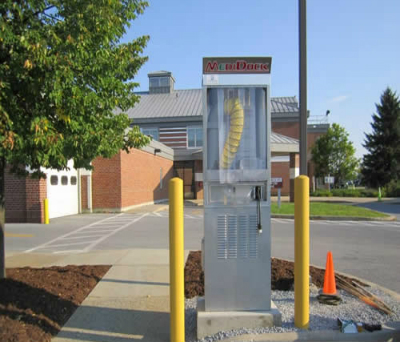
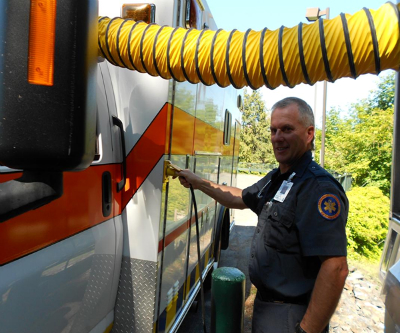 Currently available technology provides a cleaner and efficient way to meet these energy needs without running the ambulance's engine by allowing ambulances to plug directly into the electric grid, and supplying heated and cooled air to ambulance interior compartments. This equipment reduces the need for ambulance engine idling, thus improving air quality on the hospital campus while also reducing fuel consumption and wear on ambulance engines. The Vermont Department of Environmental Conservation’s Air Quality & Climate Division (AQCD), through its Vermont Diesel Emissions Reduction Grants program, provides funding and technical support to install idle-reduction technology to eliminate the need for ambulance idling at a hospital.
Currently available technology provides a cleaner and efficient way to meet these energy needs without running the ambulance's engine by allowing ambulances to plug directly into the electric grid, and supplying heated and cooled air to ambulance interior compartments. This equipment reduces the need for ambulance engine idling, thus improving air quality on the hospital campus while also reducing fuel consumption and wear on ambulance engines. The Vermont Department of Environmental Conservation’s Air Quality & Climate Division (AQCD), through its Vermont Diesel Emissions Reduction Grants program, provides funding and technical support to install idle-reduction technology to eliminate the need for ambulance idling at a hospital.
Under this grant program, seven electrically powered “kiosks” have been installed at three Vermont hospitals – Brattleboro Memorial Hospital, Porter Medical Center in Middlebury and Rutland Regional Medical Center. The kiosks power onboard equipment and provide cabin climate control for an ambulance without the need to run the engine. Vermont was the first in the nation to deploy this type of idle reduction technology, successfully serving as a demonstration for other hospitals in improving local air quality, reducing potential exhaust infiltration of hospital buildings, reducing greenhouse gas emissions, and increasing the energy efficiency of emergency services. Additionally, this idle reduction project increases community awareness about diesel pollution and hospital stewardship of public health and the environment.
"Ambulance companies save diesel fuel and reduce wear and tear on the ambulances' engines. For our patients, staff and the community, it means healthier air. With fewer emissions from tailpipes, the air quality in and around the hospital entryways is improved." - Rob Prohaska, Director, Plant Services, Brattleboro Memorial Hospital
More Documents and Resources:
Media Coverage: Brattleboro Reformer, a pdf file
Fact Sheet: Eliminating Idling of Emergency Response Vehicles at Hospitals, a pdf file
Learn more about the Vermont Diesel Emissions Reduction Grants.

